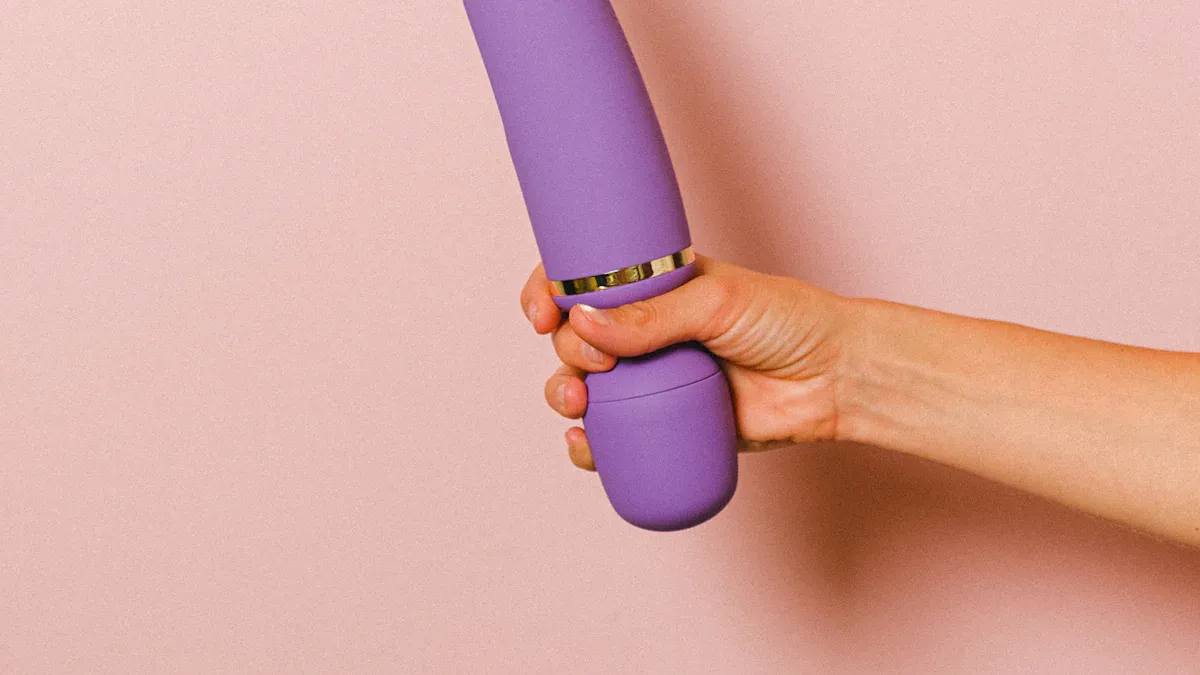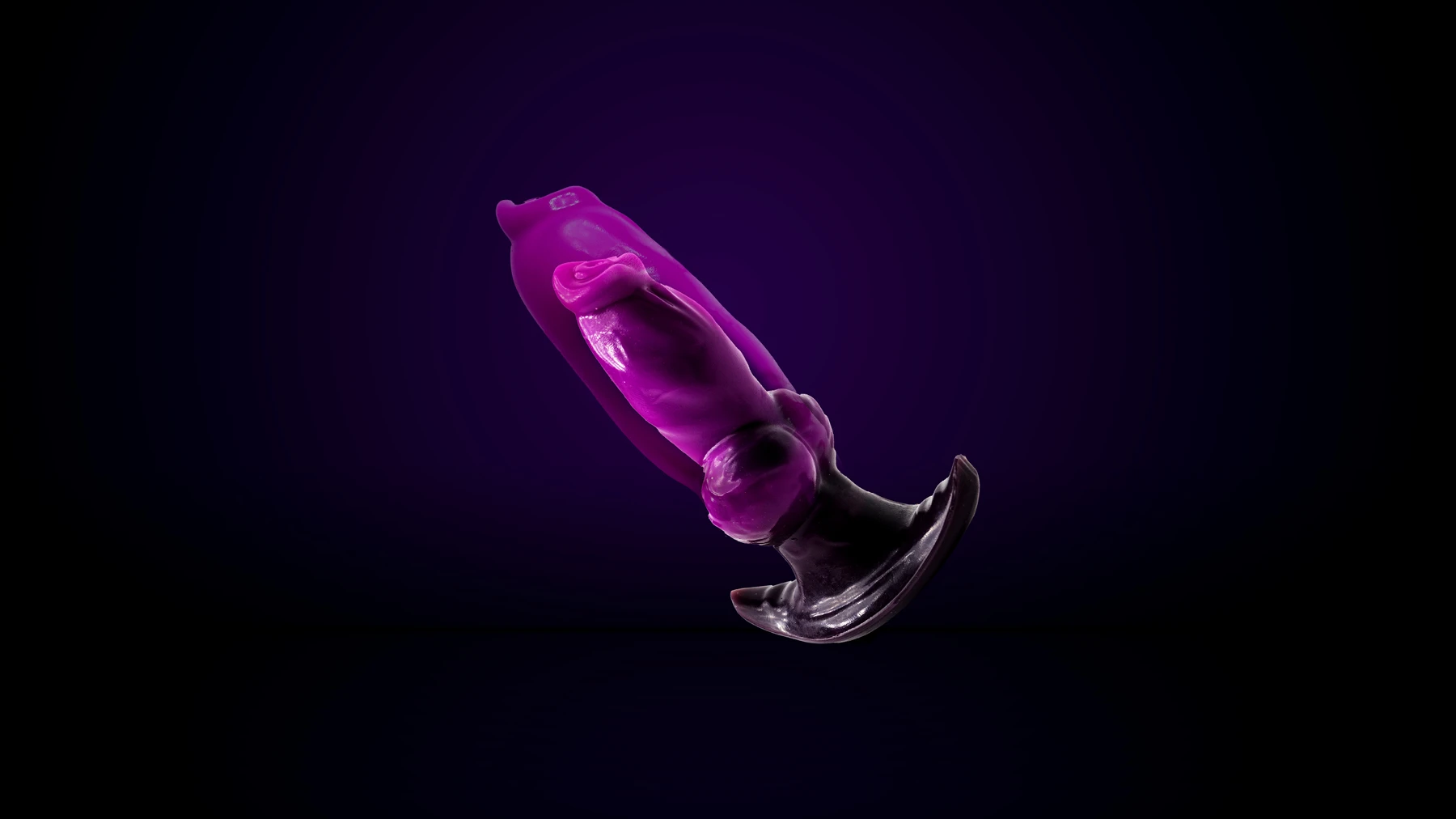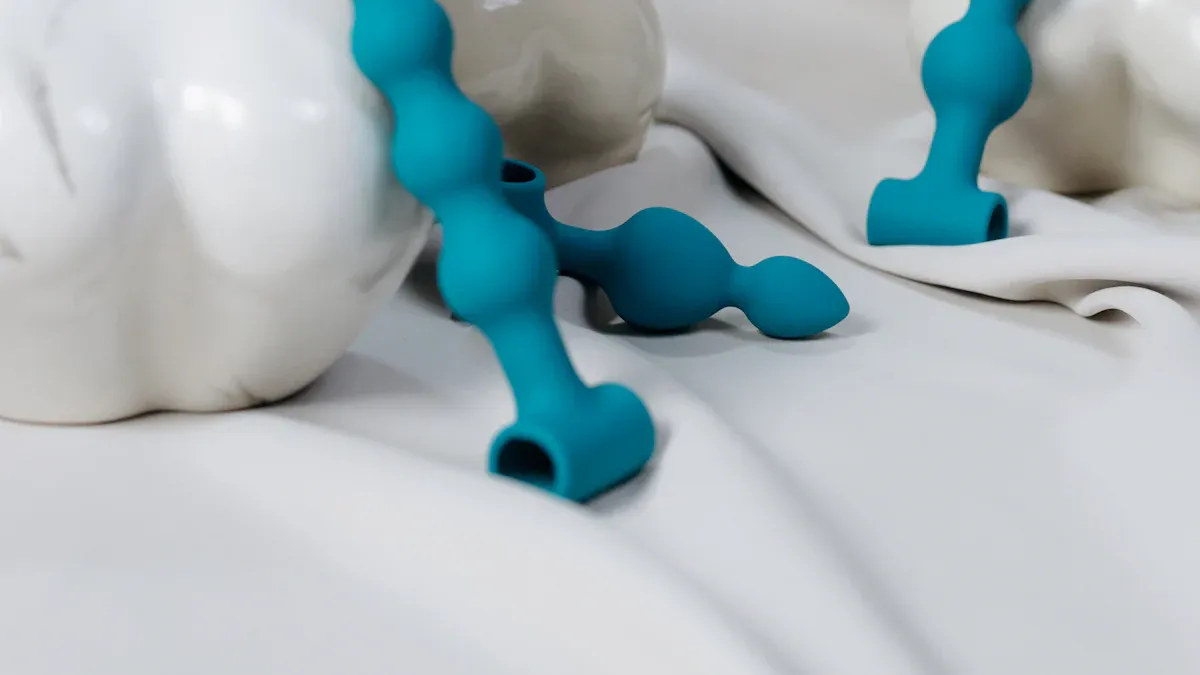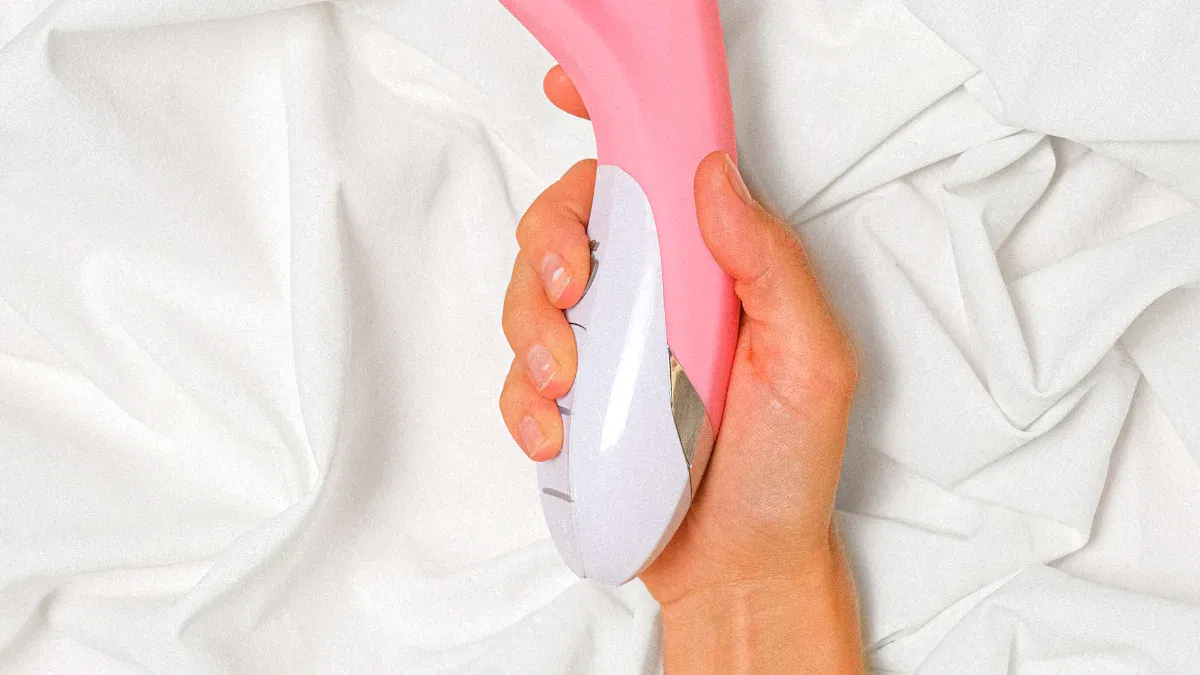Rubber Dildos Explained and How They Differ from Popular Alternatives

Rubber dildos are made from rubber, giving them a firm and dense feel. They are often more affordable compared to other materials. Many rubber dildos come in bright colors, and some even feature a glow in the dark dildo option or a suction dildo base for added versatility. Rubber dildos tend to feel heavier and bouncier than others, though they may not last as long. Despite this, people continue to buy rubber dildos because they are inexpensive and easy to find. Nowadays, many prefer silicone dildos for health and comfort reasons. Understanding the differences between dildos, vibrators, and Snake Dildos can help you choose the best sex toys for your needs. Being informed about these options allows you to make safer and more comfortable choices.
Rubber Dildos

Features and Feel
When you hold rubber dildos, they feel firm and dense. They are heavier than some other toys. Many people say rubber dildos feel bouncy when used. The outside can be smooth or a little sticky. This depends on the kind of rubber. People want dildos to feel real and comfortable. The shape and material help with this. Reviews show users care about how a dildo feels and its shape. Good reviews come from dildos that feel nice and do not hurt. The weight and bounce make rubber dildos different from others.
Types of Rubber
There are a few kinds of rubber in dildos. Standard rubber is firm and dense. Jelly rubber is soft and squishy. It also comes in bright colors. Cheap dildos often use jelly rubber because it costs less. The mix of rubber can change from one dildo to another. Some rubbers have more fillers or plasticizers. This can change how long the dildo lasts and how safe it is. Not all rubber dildos are the same. How the rubber is made changes the quality and safety.
Common Uses
Rubber dildos are good for people who want a cheap toy. You might pick rubber if you want a firmer or bouncy toy. Many new users start with rubber dildos. They are easy to find and come in many shapes and colors. Some people use them alone. Others use them with a partner. Rubber dildos do not last as long as some other toys. They can break or get damaged if used a lot.
Safety
Porosity and Hygiene
If you pick a dildo made from rubber or jelly rubber, you should know about porosity. Porous toys have tiny holes you cannot see. These holes let germs and fluids get inside the toy. This makes cleaning much harder because germs can hide deep inside. Even if you wash the outside, bacteria might stay inside. Over time, this can make the toy smell bad and raise your risk of infection. Non-porous dildos, like ones made from medical-grade silicone, glass, or stainless steel, do not have these tiny spaces. You can clean non-porous toys more easily, and they stay safer for longer. Many experts say non-porous, body-safe materials are better for hygiene and safety.
Tip: If you want a toy that is easy to clean and safer for your health, look for non-porous options.
Chemical Risks
Rubber dildos, especially those made from jelly rubber or PVC, often have chemicals called phthalates. Phthalates make the toy soft and bendy, but they can leak out when you use the toy. Studies show phthalates can mess with your hormones and may cause health problems like trouble having babies or even cancer. Some rubber toys also have other bad chemicals, like trimethyltin chloride and toluene. These can hurt your nerves and cause other serious health problems. Many cheap dildos do not list all their ingredients, so you might not know what is inside. Non-porous toys made from silicone, glass, or metal usually do not have these risks. Picking body-safe materials helps keep you safe from harmful chemicals.
Phthalates and other chemicals can:
Mess up your hormones
Cause problems with having babies or growing up
Lead to health problems that last a long time
Allergies
Some people are allergic to rubber or latex. If you feel itchy, see redness, or notice swelling after using a rubber dildo, you might have an allergy. Latex allergies can be mild or very serious. Always check the label before you buy a new toy. If you have sensitive skin or allergies, non-porous and hypoallergenic materials like silicone or glass are safer. These choices lower your chance of having an allergic reaction and help you feel more comfortable.
Note: If you ever feel discomfort or see a rash after using a new toy, stop using it and talk to a doctor.
Different Materials for Dildos

When you shop for a new dildo, you will see many materials. Each one feels different and has its own safety and cleaning needs. It is smart to learn about these materials before you buy.
Here is a table that shows the main differences:
Material | Temperature Resistance | Porosity | Durability | Cleaning Methods | Lubricant Compatibility |
|---|---|---|---|---|---|
Silicone | -40°C to +230°C | Non-porous | High | Boilable, Dishwasher safe, Hand wash | Not with silicone-based; water-based OK |
TPE | -20°C to +100°C | Porous | Moderate | Hand wash, Top-rack dishwasher (careful) | Silicone- and water-based OK |
PVC | -15°C to +60°C | Porous | Lower | Hand wash, Chemical cleaners | Silicone- and water-based OK |
Glass | Up to +500°C | Non-porous | Fragile | Boilable, Sterilizable, Hand wash | All lubricants OK |
Rubber | Similar to TPE/PVC | Porous | Lower | Gentle cleaning, Less heat resistant | Varies |
This table shows that silicone and glass are non-porous. They are safer and last longer. TPE, PVC, and rubber are porous. They can hold germs and break down faster.
Silicone Sex Toys
Silicone sex toys are very popular. They feel smooth and soft to touch. Many people like how nice they feel. Silicone is non-porous, so it does not trap germs. You can clean silicone toys with soap and water. You can also boil them or use a dishwasher. This makes cleaning easy.
Silicone toys last a long time. Some brands give a one-year or ten-year guarantee. Silicone toys do not have bad chemicals. They are safe for people with sensitive skin. Only use water-based lubricants with silicone dildos. Silicone-based lubricants can harm the toy.
Tip: If you want a safe and easy-to-clean dildo, pick silicone.
Glass and Metal
Glass dildos and metal dildos feel very different. Glass dildos are made from strong glass. They are non-porous and easy to clean. You can boil them or use strong cleaners. Glass dildos can handle hot and cold. You can warm them up or cool them down. They feel smooth and glide well.
Metal dildos are made from stainless steel. They are non-porous and do not wear out fast. You can clean metal dildos by boiling or washing with soap. Metal dildos feel heavy and solid. You can use them for temperature play too. Both glass and metal dildos are body-safe and last a long time.
Stainless steel and glass are very strong.
You can use any lubricant with glass and metal dildos.
Both are easy to hold and use.
Stone dildos, like jade or quartz, are non-porous and easy to clean. Stone dildos feel cool and smooth. Many people like how stone dildos look and feel. Stone dildos are strong, but check for cracks before using. Stone dildos can last for years if you care for them. Stone dildos are safe and do not have bad chemicals. Stone dildos are a good choice if you want something special. You can use any lubricant with stone dildos. Stone dildos are easy to sterilize. Stone dildos are not common but feel unique. Stone dildos are often handmade and come in many shapes. Stone dildos are heavy, which some people like.
Plastic and TPE
Plastic and TPE dildos are common and cost less. TPE means thermoplastic elastomer. These dildos feel soft and squishy. They are more porous than silicone, glass, or metal. This means they can hold germs and need careful cleaning. Wash them with soap and water after each use. Some TPE dildos can go in the dishwasher, but be careful.
Plastic dildos are harder and lighter. They are less porous than TPE but not as safe as silicone, glass, or metal. Both plastic and TPE dildos can break down faster than non-porous toys. Check them often for cracks or color changes. If you see damage, replace them.
Note: Always check the label for cleaning and safe lubricants. Some materials do not work with every lubricant.
When you compare these materials, non-porous options like silicone, glass, metal, and stone are safer and last longer. Rubber, TPE, and plastic dildos are cheaper but need more care and do not last as long. Picking the right material helps you stay safe and enjoy your toy for years.
Pros and Cons of Dildo Materials
Advantages of Rubber Dildos
There are a few reasons to pick rubber dildos. Rubber dildos usually cost less than other types. This helps if you want to save money. You can find them in many stores and online. They come in lots of shapes, sizes, and colors. Some stores let you choose custom colors or shapes. Rubber dildos feel firm but also bend a little. Some people like how they feel. If you have never tried a dildo before, rubber dildos are a cheap way to start.
Tip: Rubber dildos are easy to buy and come in bright colors, so you can find one that matches your style.
Disadvantages of Rubber Dildos
Rubber dildos have some problems you should know about. They are porous, so germs and fluids can get inside. This makes cleaning them much harder. It can also make you sick. Many rubber dildos have chemicals like phthalates. These chemicals can be bad for your health. Rubber dildos do not last as long as silicone, glass dildos, or metal dildos. You might see cracks or color changes after using them for a while. Experts say rubber dildos are not good for long-term use because of these risks.
Here is a table to help you compare the main materials:
Material | Pros | Cons | Safety Rating |
|---|---|---|---|
Silicone | Soft, flexible, non-porous, hypoallergenic, durable | Incompatible with silicone-based lubricants, more expensive | Very safe (✅) |
Glass | Non-porous, hypoallergenic, compatible with all lubricants | Fragile, rigid | Very safe (✅) |
Metal | Non-porous, heavy, intense stimulation, compatible with all lubricants | Rigid, expensive | Very safe (✅) |
TPE | Soft, realistic feel, affordable | Porous, short lifespan | Use with condom (⚠) |
Rubber | Flexible, cheap | Porous, may contain phthalates | Not recommended (❌) |
PVC | Lightweight, inexpensive | Porous, contains harmful chemicals | Not recommended (❌) |
Choosing the Right Material
Think about what is most important to you when picking a dildo. You want to feel safe and comfortable with your choice. Many people pick non-porous materials like silicone, glass dildos, metal dildos, or stone dildos. These are easy to clean and last longer. They also help lower your risk of getting sick or being exposed to chemicals. If you have allergies or sensitive skin, silicone or stone dildos are good picks.
You can use this checklist to help you choose:
Do you want a toy that is easy to clean?
Is safety the most important thing for you?
Do you like toys that are firm or soft?
How much money do you want to spend?
Do you want a toy that will last a long time?
Note: Always read the label for cleaning tips and which lubricants are safe. If you use a porous toy, use a condom to help keep yourself safe.
Care and Maintenance
Cleaning Rubber Dildos
Keeping your rubber dildo clean helps protect your health. Rubber is porous, so germs can hide inside. You should clean your toy before and after each use. Follow these steps for safe cleaning:
Rinse the dildo with warm water right after use.
Wash it with mild soap and water. Avoid harsh chemicals that can damage rubber.
Use a silicone-friendly sex toy cleaner or a high-quality disinfectant spray. Spray the cleaner over the whole surface and wipe with a clean cloth.
Rinse again to remove any soap or cleaner left on the toy.
Let the dildo air dry completely before you put it away.
Tip: Only use water-based lubricants with rubber toys. Other lubricants can break down the material and increase infection risks.
If your toy has removable parts, take them apart and clean each piece. Make sure everything dries fully before putting it back together.
Storage Tips
Proper storage keeps your rubber dildo in good shape. Store your toy in a cool, dry place. Keep it away from sunlight and heat, which can make rubber crack or fade. Place the dildo in a clean cloth bag or a separate box. This stops dust and lint from sticking to it. Do not let rubber toys touch other toys, especially silicone or jelly toys. Some materials can react and cause damage.
Note: Always store your toy dry. Moisture can lead to mold or bad smells.
When to Replace
Check your rubber dildo often for signs of wear. Look for cracks, changes in color, or a sticky feel. If you see any of these, it is time to get a new toy. Rubber dildos do not last as long as silicone or glass toys. Replace your toy if it starts to smell bad, even after cleaning. Using a damaged toy can put your health at risk.
When you look at rubber dildos and other materials, you notice big differences. Rubber dildos can have chemicals and are tough to clean. Silicone, glass, and stainless steel are safer and easier to wash. These materials do not let germs get inside. You should pick a toy that feels good and is easy to keep clean. Think about what makes you comfortable and safe. Always read the product details before you buy anything. Your health is important, so check for safety. If you are not sure, ask an expert or read trusted guides.





